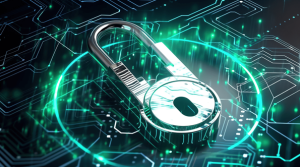The world is changing dramatically due to artificial intelligence (AI), and cybersecurity is no different. Artificial Intelligence has become a potent weapon in the battle to safeguard digital assets as cyber attacks grow more complex and widespread. But although AI presents a great chance to improve cybersecurity, it also brings new risks. This blog post examines how artificial intelligence (AI) is affecting cybersecurity, looking at both the benefits and problems it brings.
The Opportunities of AI in Cybersecurity
Improved Response and Detection of Threats
The capacity of AI to recognise and react to threats instantly is one of its biggest advantages in cybersecurity. Conventional security tools, including antivirus and firewall software, rely on signature-based detection techniques and pre-established rules. These techniques frequently take a while to react to fresh or changing threats. However, AI is able to swiftly examine large volumes of data and spot patterns that point to nefarious activities. By training algorithms to identify patterns in user behaviour, system logs, or network traffic, machine learning can identify dangers that might otherwise go undetected.
AI-driven systems can also automate the reaction to dangers that are identified. An AI system might immediately block a dubious email or URL, for instance, if it detects a phishing attempt. This

keeps consumers safe from the attack. This ability to respond quickly is essential for reducing the impact of cyberattacks.
Better Forensic and Incident Analysis
Knowing how a cyberattack transpired is crucial to averting similar ones in the future. AI can greatly improve forensics and event analysis by automating the process of searching through network traffic, logs, and other information sources. AI technologies are able to promptly determine the attack vector, the scope of the compromise, and the compromised data or systems.
Furthermore, by examining the tactics, methods, and procedures (TTPs) employed in the assault, AI can help attribute attacks to particular threat actors. This capacity is very helpful in recognising and thwarting more sophisticated attacks as well as advanced persistent threats (APTs).
Intelligence about Threats and Predictive Analytics
Predictive analytics benefits greatly from AI’s capacity to examine huge datasets and spot trends. Artificial Intelligence can recognise patterns and forecast potential dangers by examining past hack data. With the help of this capacity, businesses can address cybersecurity from a proactive standpoint and put countermeasures in place before any attacks even arise.
Furthermore, by compiling and evaluating information from many sources, including threat feeds, dark web monitoring, and open-source intelligence (OSINT), AI can improve threat intelligence. Threat intelligence solutions powered by artificial intelligence (AI) can give businesses useful information about new risks and keep them one step ahead of hackers.
Automating Continual Security Operations
The sheer amount of warnings and tasks that cybersecurity personnel must handle frequently leaves them feeling overburdened. By automating standard security procedures like patch management, vulnerability scanning, and log analysis, AI can lessen this load. Artificial Intelligence frees up security experts’ time to concentrate on more strategic and sophisticated responsibilities like threat hunting and incident response.
Additionally, automation lowers the possibility of human error—a frequent contributing element to security breaches. By guaranteeing that important operations are performed precisely and consistently, AI-driven systems can lower the possibility of security lapses.
AI’s Dangers to Cybersecurity
While there are numerous advantages to AI, there are also new threats that businesses need to be aware of.
AI-Driven Cyberattacks
AI can be weaponised by cybercriminals in the same way that it can be used to protect against online threats. Cyberattacks enabled by AI are more complex and challenging to identify than conventional attacks. Attackers can, for instance, employ AI to automatically create phishing emails that are convincing and highly personalised, increasing the likelihood that victims will fall for them.
AI has the ability to get beyond conventional security measures as well. Adversarial AI approaches, for example, can be used to fool machine learning algorithms into incorrectly classifying data or making conclusions. Attackers might be able to avoid being discovered by AI-powered security systems as a result.
A Greater Surface Area of Attack
Organisations may unintentionally increase their attack surface when they use AI-driven technology more and more. Artificial intelligence (AI) systems frequently rely on vast volumes of data, including private information that might be targeted by hackers. Furthermore, assaults like data poisoning, in which adversaries alter the data used to train machine learning models, can affect AI systems directly and result in inaccurate or dangerous outputs.
Another difficulty with AI systems is their complexity. AI models are frequently viewed as “black boxes,” which means that humans find it difficult to understand how they make decisions. It may be challenging to locate and fix vulnerabilities in AI systems as a result of this lack of transparency.
Privacy and Ethical Issues

Concerns about ethics and privacy are brought up by the usage of AI in cybersecurity. Privacy may also be violated by AI systems that keep an eye on user behaviour, network traffic, or communications for indications of malicious activity. Artificial intelligence (AI)-driven surveillance instruments have the potential to gather and examine private user data by accident, so breaching their privacy.
Another concern with AI-driven security solutions is bias. A biassed AI model may target particular user groups disproportionately or mark valid activities as suspect if it was trained on biased data. False positive results, discrimination, or other unforeseen effects could result from this.
Dependency and Deficits in Skill
Organisations running the risk of being unduly reliant on AI for cybersecurity are those that depend on it more and more. Although AI can automate a lot of jobs, it cannot take the place of human skill and judgement. An over-reliance on AI could result in apathy and a decrease in manual monitoring and critical thinking, which could open the door to security flaws.
Furthermore, the demand for specialised skills, which are in limited supply, has increased due to the fast adoption of AI in cybersecurity. It could be difficult for organisations to hire and retain experts who know how to create, implement, and oversee AI-driven security systems.
Managing AI’s Potential and Dangers for Cybersecurity
In order to optimise AI’s benefits for cybersecurity while reducing related risks, enterprises ought to take a well-rounded approach:
Invest in AI Carefully: Although AI can improve cybersecurity, it’s important to be aware of its drawbacks and hazards. AI solutions should be carefully considered by organisations to make sure they meet their security requirements and risk tolerance.
Boost Human Expertise: AI should be used to supplement human knowledge, not to replace it. To guarantee that their security staff are proficient in utilising AI tools and comprehending their results, organisations ought to allocate resources towards training and growth.
Give Transparency and Ethics Top Priority: When using AI systems, businesses should give transparency and ethical issues top priority. This involves making certain that AI-powered security solutions respect user privacy and are impartial.
Put Strong Security Measures in Place: Organisations should put strong security measures in place, such as frequent audits, safe data handling procedures, and adversarial attack monitoring, to prevent cybercriminals from targeting AI systems.
Conclusion
AI is changing cybersecurity by providing strong instruments for threat detection, prevention, and response. But the very technology that fortifies defences can also be used by adversaries, posing additional difficulties. Organisations may create strategies that leverage AI’s capabilities while reducing its risks by comprehending both the benefits and challenges it poses. This will ultimately lead to the creation of a more secure digital environment.

